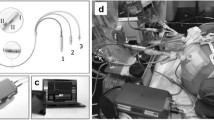Abstract
Background
Electrocorticography (ECoG) in brain-injured patients allows to detect spreading depolarization, a potential mechanism of secondary ischemia. Here, we describe the relationship of spreading depolarization with changes in cerebral hemodynamics using a brain tissue probe applying near infrared spectroscopy (NIRS).
Methods
Simultaneous ECoG and NIRS monitoring was performed in a patient with severe aneurysmal subarachnoid hemorrhage. Changes in cerebral blood oxygenation and regional cerebral blood volume were studied before and after the occurrence of spreading depolarization. Cerebral blood flow measurements were performed daily using an indocyanine green dye dilution mode.
Results
Single events of spreading depolarizations demonstrated with transient hyperoxic responses and increase in cerebral blood volume. On the other hand, temporal clusters of recurrent spreading depolarizations were associated with prolonged hypoxic responses and decrease in cerebral blood volume. Cerebral blood flow measurements showed higher values before compared to after onset of spreading depolarization (33.7 ± 8.4 vs. 24.2 ± 4.5 ml/100 g/min).
Conclusions
The findings suggest that NIRS monitoring in the cerebral white matter might reflect the hemodynamic signature of spreading depolarization detected by ECoG recordings. This is of potential interest for the further development of both neuromonitoring methods.


Similar content being viewed by others
References
Hartings JA, Watanabe T, Dreier JP, Major S, Vendelbo L, Fabricius M. Recovery of slow potentials in AC-coupled electrocorticography: application to spreading depolarizations in rat and human cerebral cortex. J Neurophysiol. 2009;102:2563–75.
Somjen GG. Mechanisms of spreading depression and hypoxic spreading depression-like depolarization. Physiol Rev. 2001;81:1065–96.
Strong AJ, Anderson PJ, Watts HR, et al. Peri-infarct depolarizations lead to loss of perfusion in ischaemic gyrencephalic cerebral cortex. Brain. 2007;130:995–1008.
Bosche B, Graf R, Ernestus RI, et al. Recurrent spreading depolarizations after subarachnoid hemorrhage decreases oxygen availability in human cerebral cortex. Ann Neurol. 2010;67:607–17.
Dreier JP, Major S, Manning A, et al. Cortical spreading ischaemia is a novel process involved in ischaemic damage in patients with aneurysmal subarachnoid haemorrhage. Brain. 2009;132:1866–81.
Sakowitz OW, Santos E, Nagel A, et al. Clusters of spreading depolarizations are associated with disturbed cerebral metabolism in patients with aneurysmal subarachnoid hemorrhage. Stroke. 2013;44:220–3.
Strong AJ, Fabricius M, Boutelle MG, et al. Spreading and synchronous depressions of cortical activity in acutely injured human brain. Stroke. 2002;33:2738–43.
Fabricius M, Fuhr S, Bhatia R, et al. Cortical spreading depression and peri-infarct depolarization in acutely injured human cerebral cortex. Brain. 2006;129:778–90.
Keller E, Froehlich J, Muroi C, Sikorski C, Muser M. Neuromonitoring in intensive care: a new brain tissue probe for combined monitoring of intracranial pressure (ICP) cerebral blood flow (CBF) and oxygenation. Acta Neurochir Suppl. 2011;110:217–20.
McCormick PW, Stewart M, Goetting MG, Dujovny M, Lewis G, Ausman JI. Noninvasive cerebral optical spectroscopy for monitoring cerebral oxygen delivery and hemodynamics. Crit Care Med. 1991;19:89–97.
Jobsis FF. Non-invasive, infra-red monitoring of cerebral O2 sufficiency, bloodvolume, HbO2-Hb shifts and bloodflow. Acta Neurol Scand Suppl. 1977;64:452–3.
Keller E, Nadler A, Alkadhi H, Kollias SS, Yonekawa Y, Niederer P. Noninvasive measurement of regional cerebral blood flow and regional cerebral blood volume by near-infrared spectroscopy and indocyanine green dye dilution. Neuroimage. 2003;20:828–39.
Mutoh T, Ishikawa T, Suzuki A, Yasui N. Continuous cardiac output and near-infrared spectroscopy monitoring to assist in management of symptomatic cerebral vasospasm after subarachnoid hemorrhage. Neurocrit Care. 2010;13:331–8.
Lauritzen M. Pathophysiology of the migraine aura. The spreading depression theory. Brain. 1994;117(Pt 1):199–210.
Dreier JP, Korner K, Ebert N, et al. Nitric oxide scavenging by hemoglobin or nitric oxide synthase inhibition by N-nitro-l-arginine induces cortical spreading ischemia when K+ is increased in the subarachnoid space. J Cereb Blood Flow Metab. 1998;18:978–90.
Shin HK, Dunn AK, Jones PB, Boas DA, Moskowitz MA, Ayata C. Vasoconstrictive neurovascular coupling during focal ischemic depolarizations. J Cereb Blood Flow Metab. 2006;26:1018–30.
Acknowledgments
This work was supported by the Stiefel-Zangger Foundation of the University Zurich, Switzerland and NeMoDevices AG, Zurich, Switzerland.
Author information
Authors and Affiliations
Corresponding author
Rights and permissions
About this article
Cite this article
Seule, M., Keller, E., Unterberg, A. et al. The Hemodynamic Response of Spreading Depolarization Observed by Near Infrared Spectroscopy After Aneurysmal Subarachnoid Hemorrhage. Neurocrit Care 23, 108–112 (2015). https://doi.org/10.1007/s12028-015-0111-3
Published:
Issue Date:
DOI: https://doi.org/10.1007/s12028-015-0111-3




